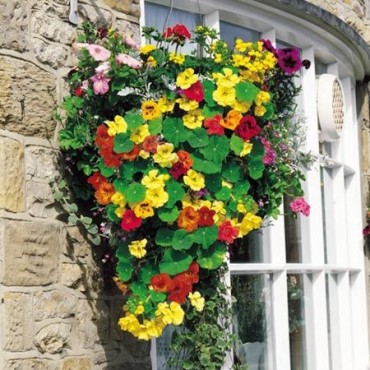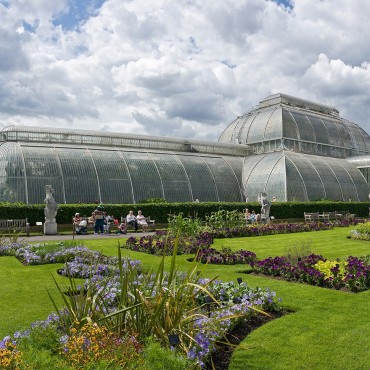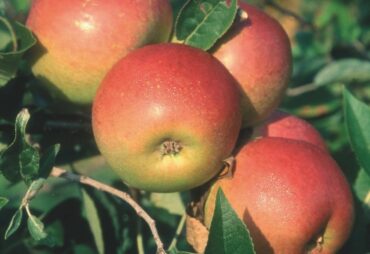Since 1913, the RHS Chelsea Flower Show has been held at London’s Royal Hospital Chelsea every year. This prestigious event is attended by top horticultural professionals, the largest and best horticultural companies, and avid gardening enthusiasts.
Therefore, it is only right that Suttons is front and centre with ‘Plant of the Year’ worthy plants. But what is the Plant of the Year Award?
RHS Chelsea Plant of the Year Award
The judging panel comprises of a group of experts with a wealth of knowledge and passion who come together, volunteering their time to make the incredibly tough decision on the winning plant. The judges will be looking for the winning criteria which will need to include all three of the following features:
INNOVATION – The plant must be genuinely new and offer significant benefits within those features. This will outweigh a new colour on an existing plant for example.
APPEAL – Will the plant stand the test of time? It will need to sustain its popularity to secure a place with those of true significance.
EXCELLENCE AND IMPACT – Both judges and gardeners will be looking for the “wow” factor. So, all the short-listed nominees will be on show at Chelsea on the promenade within the pavilions. Specimens on display will need to be presented at their best. It is this that will give them the conviction in their decision making, for then they will know they have chosen the right winning plant.
The shortlisted products will be judged virtually by a panel of experts including renowned entrepreneur and Dragon’s Den investor Deborah Meaden, gardening writer Peter Seabrook and Chair Chris Harrop. The winner will be announced as part of Virtual Chelsea on Monday 18 May 2020.
This is your chance to get involved. A People’s Choice vote for the Garden Product of the Year will follow, where virtual visitors will be able to vote for their top product from the shortlist. Open from Monday 18 until Friday 22 May, the People’s Choice winner will be revealed on the final day of the show, Saturday 23 May. Make sure you vote for your favourites!
Imagine yourself standing in front of the sea of faces of the most knowledgeable bunch of horticulturalists in the country, with just 90 seconds to describe what makes your plant special.
This is what happens if you’re lucky enough to have a plant shortlisted as a finalist at the RHS Chelsea Flower Show. Now imagine standing there, waiting for the results and euphoria of hearing that your plant has been chosen as the RHS ‘Plant of the Year’ winner! We had the huge honour of experiencing exactly that in 2017 and 2019 with the Dwarf Mulberry – Charlotte Russe and the Sedum Atlantis respectively.
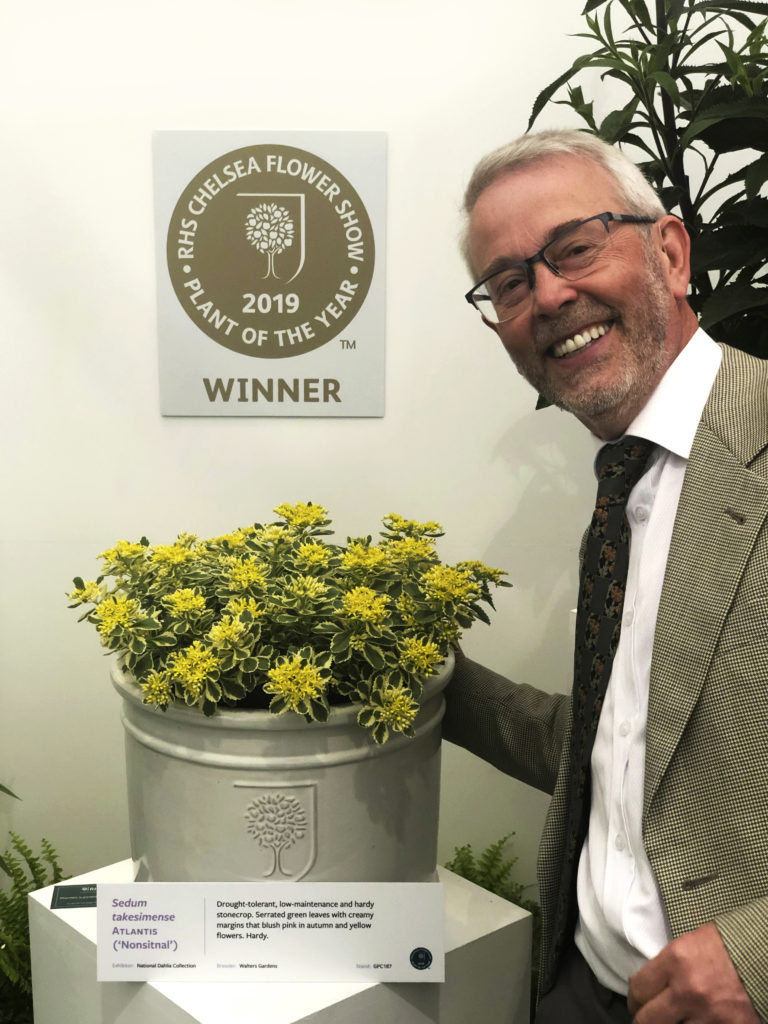
As you can imagine a huge amount of hard work goes into developing all of the plants that are entered for ‘Plant of the Year’. The Dwarf Mulberry – Charlotte Russe for example took 40 years of selective breeding by Mr. Hajime Matsunaga San. We then carry out our own testing of the plants hoping that they will perform under UK conditions. Despite all of our best efforts, in 2018 we weren’t able to find any plants that hand on heart, we felt that reached the high standards required.
For the year of 2020, we are absolutely delighted that we have found plants that we are excited about and submitting to be professionally scrutinized by the RHS judges.
The RHS Chelsea Flower Show ‘Plant of the Year’ Award celebrates the exciting range of new plants launched at the show. The prestige of winning this Award is recognised around the world and the show is the ideal global platform for the launch of new plants that often go on to be best sellers.
In 2017 and 2019 we were delighted to introduce, through our partner exhibitors, the winning plants in the RHS Chelsea Plant of the Year competition. Unfortunately, it’s now been confirmed that the competition isn’t going ahead in 2020.
However, we’ve decided to introduce you to our ‘would-be’ nominees, which we will now nominate in 2021, so their beauty and unique qualities can still shine in the spotlight. Read on and be one of the first to discover and grow these exciting, new & exclusive introductions from Suttons at home!
Below are Suttons’ 2020 Nominees
Jacaranda Bonsai Blue

The story of the Jacaranda Bonsai Blue
If you have travelled to some far flung places, you may have seen the streets lined with huge Jacaranda trees growing to 20 metres high, arching overhead, enclosing you in a giant ripcurl wave effect of the brightest blue flowers both above your head and below your feet. In fact, the capital of South Africa, Pretoria, is also known as Jacaranda city due to its prevalence!
Around 15 years ago, Mr Sakai made a chance discovery in Japan of a single flowering branch on a young Jacaranda tree (they normally take up to 15 years to flower). After more than 10 years of careful selective breeding Mr Sakai has finally perfected the early years flowering, dwarf Jacaranda that you see here, so thanks to his efforts, any of us can enjoy this wonderful plant in our own gardens or patios.
Now at last, UK gardeners can also grow and appreciate the soft, fern like foliage of this world first, compact Jacaranda but also be astonished by its breath-taking flowers.
Growing
Bonsai Blue prefers well-draining, enriched soil and will require regular watering, especially during the first growing season. However, once established, you can reduce the frequency of watering.
This dwarf variety is heat & drought tolerant and its rounded habit & compact height protects itself from frosts below -2 degrees. Previously grown in the UK for their beautiful fern like foliage, Bonsai Blue also provides stunning blue flowers in late May-June. Prune annually to maintain the desired size.

Shop Jacaranda – Bonsai Blue Here
Limonium Dazzle Rocks
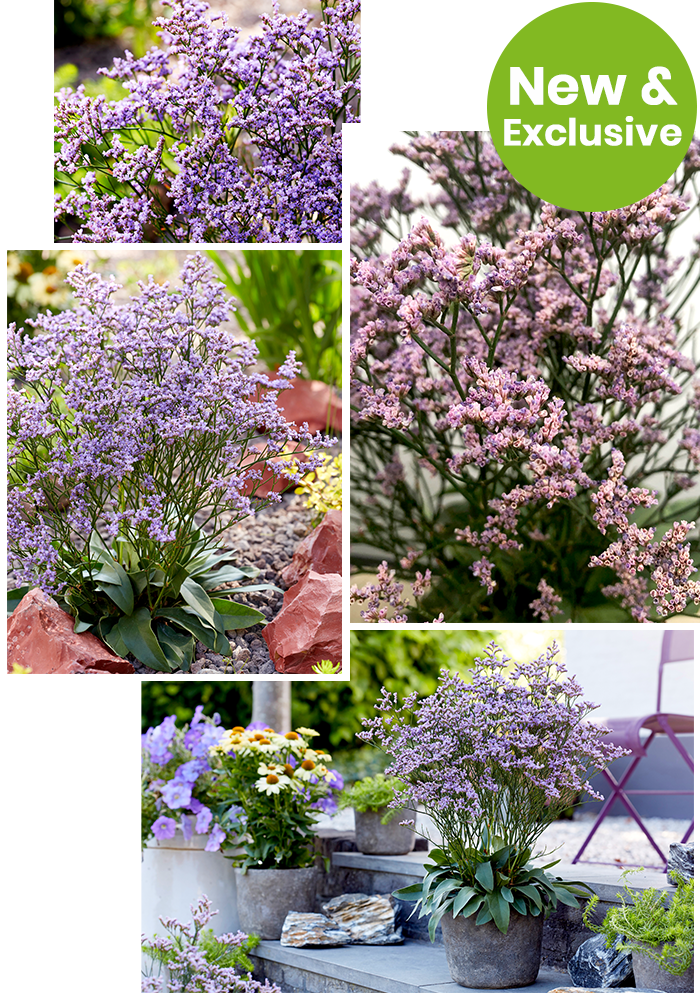
The story of the Limonium Dazzle Rocks
Completely unique in the Limonium genus, this stunning and brand-new variety is a breeding breakthrough and answers all the problems many have had with other varieties over the years.
Peter van Stejn specialises in finding and breeding plants that will dazzle, both in the garden and as cut flowers. Having collected Limonium gmelinii seed from the wild in Hungary, where they exhibit wide variations in the number and height of flower stems, Peter spent ten years of selective crossing to develop this compact plant with many more flower stems than normal.
Unusual in being both compact, fully hardy and floriferous, Dazzle Rocks creates long lasting, 30-40cm high pillows in ever popular bright blue shades from June – September. They look brilliant in a cut flower display and can also be dried for the winter months. Easy to maintain and loved by the pollinating insects too!
Growing
Grow Limonium in moist but well-drained soil in full sun. Once established, it’s fairly drought-tolerant, but thrives equally well in better conditions.
Dazzle Rocks only grows to about 30-40 cm, but it’s hardy to -25C with masses of Lavender coloured flowers above the silvery green foliage. The strong stems that hold the flowers are produced in great abundance to make it even more attractive & hardy.
Flowers June/July September. Ht. 30-40cm (12-16″); spread 20-30cm (8-12″). Delivery late June onwards.
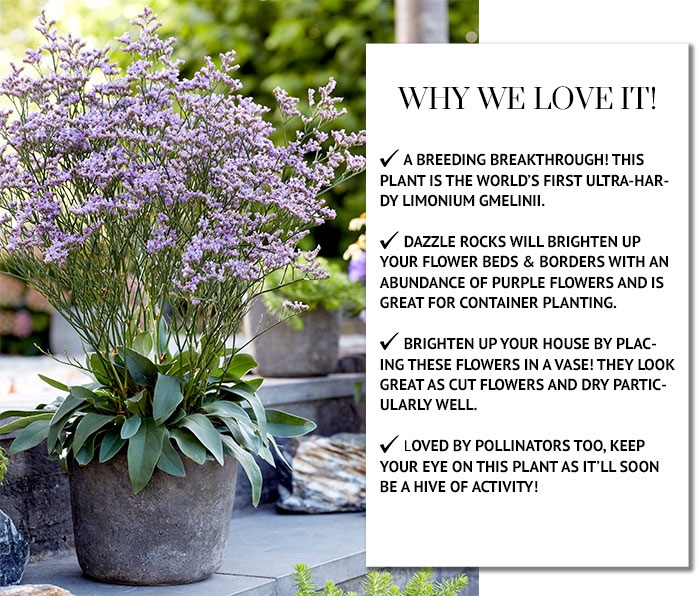
Shop Limonium – Dazzle Rocks Here
Suttons’ Previous RHS Chelsea Plant of the Year Winners:
2019 – Sedum Atlantis
Sedum Atlantis is a plant for our times; it’s drought tolerant, suitable for small spaces and attractive to bees. Its striking foliage forms rosettes of serrated green leaves with thick, creamy margins and tips that turn a pink blush in the autumn. The pink tinged flower buds open to bee-magnet yellow flowers. New leaves emerge in a beautifully creamy white, before developing into an attractive green with striking white borders and gradually forming a half metre wide cushion of drought resistant leaves. To top it off, this plant then covers itself with a foam of bee and butterfly magnet yellow flowers from July through to September.

Growing
Sedum Atlantis is extremely versatile and is just as happy in a hanging basket, window box or pots for indoor displays as it is outdoors in rockeries or borders. Beginners and time-poor gardeners will love its drought tolerance while bees love it for its pollen! However, like all plants, they do still need water, so ensure they don’t dry out completely in dry spells, particularly when your plant is first establishing.
Flowers July-September. Height 15cm (6″); spread 30cm. (12″)
2017 – Mulberry Bush Charlotte Russe
We know it can be tricky to find these fruits in supermarkets and you can now have all the joys of growing your own mulberries without the hassle of keeping a large tree! This dwarf, compact variety only reaches a height of approximately 1.5 meters, making it suitable for any garden. It’s self-pollinating, fully hardy and fruits on both old and new wood, so you can be pick mulberries within the first year – from May right through until September!
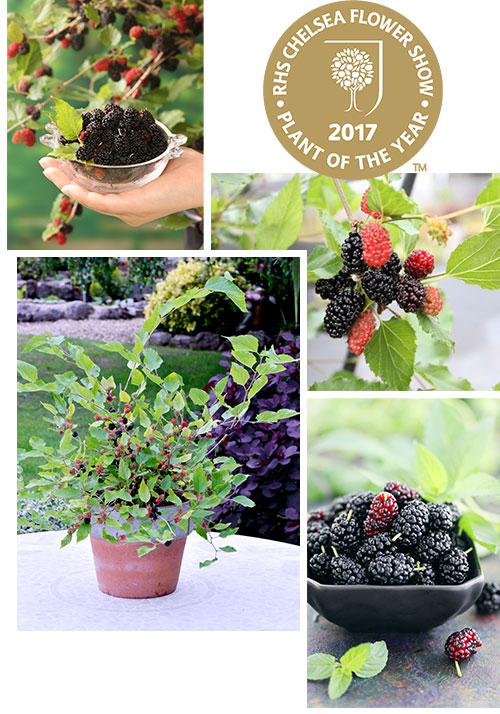
Growing
Choose a sunny position and a good fertile ground adding multi-purpose compost. The soil should be moisture retentive and free draining. It’s also perfect for growing in a pot! Wherever you choose, the plant may still need watering for the first year or so and during periods of dry weather.
Only prune dead wood or inwards growing and crossing branches or longer shoots, to keep the plant in a nice rounded mound shape.
Flowers May-September. Height 150cm (59”); spread 150cm (59”).
Last Updated on December 22, 2023 by Suttons Horticultural Team



